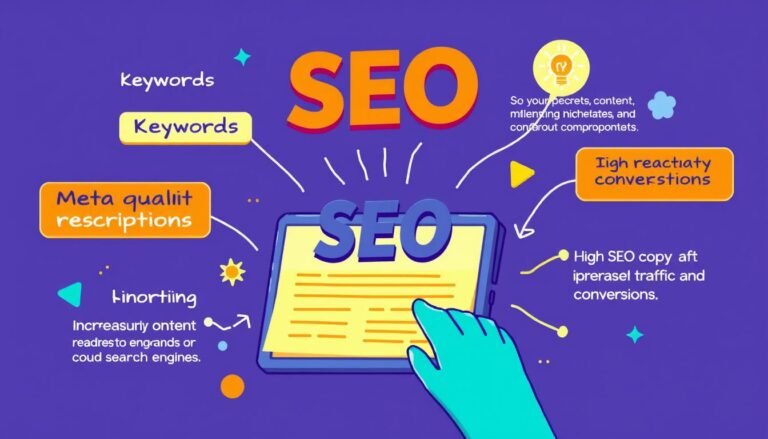Comprehensive Guide to Conversion Rate Optimization
Did you know that implementing modest CRO efforts can increase conversion rates by 5-10%? In today’s digital world, Conversion Rate Optimization (CRO) is key for businesses to grow online. This guide will help you understand CRO and how to boost your website’s conversions.
Businesses aim to turn more visitors into customers. The importance of this process is huge. For example, UnboundMerino.com saw a 44% increase in conversions, adding $216K to their annual revenue. This shows how CRO can really help a company’s profits.
We’ll explore CRO’s benefits, stats, and how to apply it to your business. By the end, you’ll know how to use data to improve your online success. Let’s start this CRO journey together, aiming for growth and profits through better website conversions.
Key Takeaways
- Modest CRO efforts can lead to a 5-10% increase in conversion rates.
- Successful examples include significant revenue boosts from improved conversion strategies.
- Understanding user behavior through tools like heat maps and surveys is essential.
- A/B testing can reveal effective changes that might dramatically increase conversions.
- Mobile responsiveness and intuitive navigation enhance user experience significantly.
- Consistent CRO applications are vital for sustainable results over time.
Understanding Conversion Rate Optimization (CRO)
In today’s digital world, standing out is key. Conversion Rate Optimization (CRO) helps by making more visitors do what you want them to on your site. It’s vital for businesses looking to boost their online success.
Definition of CRO
The definition of CRO is about making more people take actions on your website. This could mean buying something, signing up for newsletters, or interacting with your content. CRO uses many strategies, like making your site easier to use and studying how people behave. By focusing on making users happy, you can get more people to take action.
The Importance of Conversion Rates
Conversion rates are super important in digital marketing. They mean more sales without bringing in more visitors. For example, changing a call-to-action from “Book a Free Survey” to “Get a Free Quote” can increase conversions by up to 60%. Making forms easier to fill out also makes users happier and can lead to more conversions.
Numbers show that U.S. e-commerce sites averaged a 2.3% conversion rate in 2022’s second quarter. In Great Britain, the rate was over 4%. These figures show how CRO can give you an edge. Plus, making your site load faster can keep users around longer and make them more engaged.
| Strategy | Impact on Conversion Rate |
|---|---|
| Changing CTA Text | +60% |
| Reducing Form Fields | Higher performance |
| One-Click Logins | Improved experience |
| Guiding Password Creation | Enhanced filling process |
| Page Load Timeliness | Critical impact |
Key Benefits of Implementing CRO
Using conversion rate optimization (CRO) brings big wins for businesses wanting to stand out. It can help increase revenue, make users more engaged, and boost website conversions. By focusing on making the visitor’s experience better and making things easier, companies can see big results without getting more visitors.
Increasing Revenue without Additional Traffic
CRO is great for making more money without getting more visitors. By looking at how customers move through the site and tweaking key parts, companies can make their current visitors more effective. Research shows that finding and improving the right spots can help use marketing money better, leading to more revenue.
It helps figure out which channels and ads get the best results. This means using resources where they do the most good.
Improving User Engagement and Retention
Getting users to stick around is key to keeping customers loyal. CRO makes sites more engaging and easy to use, making people want to look around more and connect with the content. By using data to make these improvements, like cutting down on people leaving quickly and improving how customers interact, companies can build strong bonds with their audience.
| Benefit | Description |
|---|---|
| Increase Revenue | Unlock revenue growth by converting existing site traffic successfully. |
| Reduce Acquisition Costs | Maximize resource efficiency through better-optimized landing and checkout pages. |
| Enhance User Satisfaction | Create user-centric experiences that foster engagement and loyalty. |
| Data-Driven Insights | Implement A/B testing to derive valuable insights into user behavior. |
| Optimize Marketing Efforts | Focus on the most effective channels and content that drive conversions. |
Comprehensive Guide to Conversion Rate Optimization
Understanding the Four Main Elements of Conversion is key to boosting your website’s performance. These elements work together to engage visitors better and increase conversion rates. We’ll explore these elements and how to track success with CRO Metrics.
The Four Main Elements of Conversion
The core of CRO includes:
- Conversion Research: Using tools like heatmaps and user testing to understand what visitors like and do.
- User Experience (UX): Making your website easy to use and navigate for a better experience.
- Website Persuasion: Applying effective writing and psychology to guide visitors to take action.
- A/B Testing: Testing different page versions to see what works best for conversions.
Measuring Success: What Metrics Matter
Success in conversion optimization means tracking key CRO Metrics. To see how well your strategies work, focus on these metrics:
| Metric | Definition | Importance |
|---|---|---|
| Conversion Rate | The percentage of visitors who complete a desired action. | Shows how well your CRO efforts are doing. |
| Average Order Value (AOV) | The average amount spent per transaction. | Helps understand profitability and revenue potential. |
| Customer Acquisition Cost (CAC) | The total cost of getting a new customer. | A lower CAC means a better conversion strategy. |
| Return on Investment (ROI) | The revenue made versus the costs of CRO efforts. | Shows the success and value of your conversion efforts. |
Strategies for Optimizing Website Conversions
To boost website conversions, focus on Landing Page Optimization. Use clear calls-to-action and engaging content. Add elements that guide users. This way, you can make pages that connect better with users and push them through the conversion process.
Utilizing Landing Page Optimization Techniques
Best practices in Landing Page Optimization grab users’ attention and cut down cart abandonment. This issue affects 69.23% of shoppers online. Using headlines and trust factors like testimonials can boost conversions by up to 58%. These elements are key for a winning strategy.
Implementing A/B Testing Techniques Effectively
A/B Testing is crucial for finding the best website variations. By testing different designs and messages, companies can see which ones perform better. This helps focus on what the audience likes, leading to more engagement and more sales.
Enhancing User Experience and Navigation
Improving User Experience means making the site easy to navigate from start to finish. Cutting down on bounce rates and optimizing the layout keeps users interested. Using data to understand what visitors want creates a better experience. This makes the site more welcoming and boosts conversions.
Source Links
- The Ultimate Guide to Conversion Rate Optimization (2024)
- A comprehensive guide to conversion rate optimization
- What is Conversion Rate Optimization (CRO)? A Complete Guide
- Conversion Rate Optimization (CRO): The Complete Guide
- Conversion Rate Optimization (CRO): 8 Ways To Get Started
- Top 8 Key Benefits of Conversion Rate Optimization | VWO
- Why CRO Matters: 6 Benefits of Conversion Rate Optimization
- Conversion Rate Optimization: The Definitive Guide
- A Beginner’s Guide to Conversion Rate Optimization (CRO)
- Kindly
- Top 20 Conversion Rate Optimization Tips | VWO








